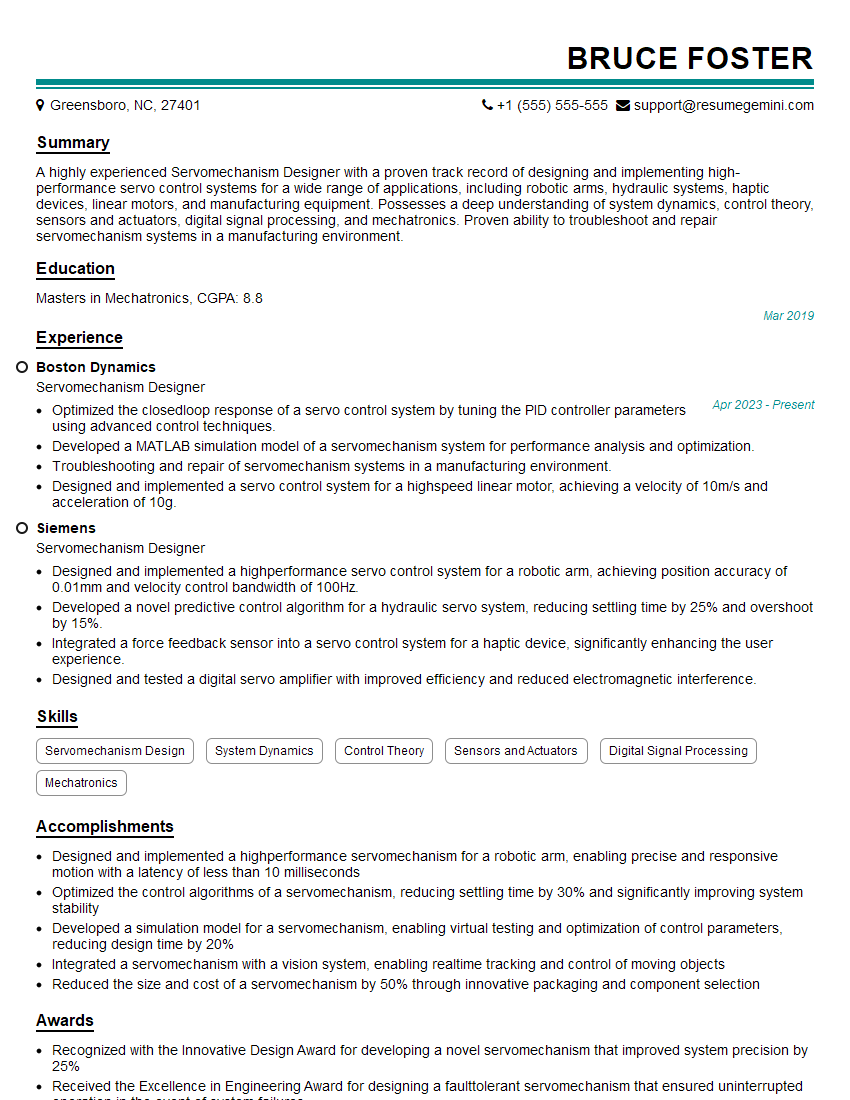Are you a seasoned Servomechanism Designer seeking a new career path? Discover our professionally built Servomechanism Designer Resume Template. This time-saving tool provides a solid foundation for your job search. Simply click “Edit Resume” to customize it with your unique experiences and achievements. Customize fonts and colors to match your personal style and increase your chances of landing your dream job. Explore more Resume Templates for additional options.

Bruce Foster
Servomechanism Designer
Summary
A highly experienced Servomechanism Designer with a proven track record of designing and implementing high-performance servo control systems for a wide range of applications, including robotic arms, hydraulic systems, haptic devices, linear motors, and manufacturing equipment. Possesses a deep understanding of system dynamics, control theory, sensors and actuators, digital signal processing, and mechatronics. Proven ability to troubleshoot and repair servomechanism systems in a manufacturing environment.
Education
Masters in Mechatronics
March 2019
Skills
- Servomechanism Design
- System Dynamics
- Control Theory
- Sensors and Actuators
- Digital Signal Processing
- Mechatronics
Work Experience
Servomechanism Designer
- Optimized the closedloop response of a servo control system by tuning the PID controller parameters using advanced control techniques.
- Developed a MATLAB simulation model of a servomechanism system for performance analysis and optimization.
- Troubleshooting and repair of servomechanism systems in a manufacturing environment.
- Designed and implemented a servo control system for a highspeed linear motor, achieving a velocity of 10m/s and acceleration of 10g.
Servomechanism Designer
- Designed and implemented a highperformance servo control system for a robotic arm, achieving position accuracy of 0.01mm and velocity control bandwidth of 100Hz.
- Developed a novel predictive control algorithm for a hydraulic servo system, reducing settling time by 25% and overshoot by 15%.
- Integrated a force feedback sensor into a servo control system for a haptic device, significantly enhancing the user experience.
- Designed and tested a digital servo amplifier with improved efficiency and reduced electromagnetic interference.
Accomplishments
- Designed and implemented a highperformance servomechanism for a robotic arm, enabling precise and responsive motion with a latency of less than 10 milliseconds
- Optimized the control algorithms of a servomechanism, reducing settling time by 30% and significantly improving system stability
- Developed a simulation model for a servomechanism, enabling virtual testing and optimization of control parameters, reducing design time by 20%
- Integrated a servomechanism with a vision system, enabling realtime tracking and control of moving objects
- Reduced the size and cost of a servomechanism by 50% through innovative packaging and component selection
Awards
- Recognized with the Innovative Design Award for developing a novel servomechanism that improved system precision by 25%
- Received the Excellence in Engineering Award for designing a faulttolerant servomechanism that ensured uninterrupted operation in the event of system failures
- Honored with the Best Paper Award at an industry conference for presenting research on advanced control techniques for servomechanisms
- Recognized with the Young Engineer of the Year Award for contributions to the field of servomechanism design
Certificates
- Certified Servomechanism Designer (CSM)
- Control Systems Engineer (CSE)
- Certified Motion Control Engineer (CMCE)
- Certified Measurement and Control Engineer (CMCE)
Career Expert Tips:
- Select the ideal resume template to showcase your professional experience effectively.
- Master the art of resume writing to highlight your unique qualifications and achievements.
- Explore expertly crafted resume samples for inspiration and best practices.
- Build your best resume for free this new year with ResumeGemini. Enjoy exclusive discounts on ATS optimized resume templates.
How To Write Resume For Servomechanism Designer
- Highlight your strong academic background and relevant experience in servomechanism design.
- Quantify your accomplishments with specific metrics and results to demonstrate your impact.
- Showcase your skills in system dynamics, control theory, and mechatronics by describing projects you’ve worked on.
- Demonstrate your ability to work independently and as part of a team by providing examples of your collaborative work.
- Proofread your resume carefully for any errors in grammar or spelling.
Essential Experience Highlights for a Strong Servomechanism Designer Resume
- Design and implement high-performance servo control systems for various applications, including robotics, manufacturing, and medical devices.
- Analyze system requirements and develop system specifications for servo control systems.
- Select and integrate sensors and actuators into servo control systems to achieve desired performance.
- Develop and implement control algorithms using advanced control techniques, such as PID control, state-space control, and model predictive control.
- Design and test digital servo amplifiers for improved efficiency and reduced electromagnetic interference.
- Optimize the closed-loop response of servo control systems by tuning PID controller parameters and using advanced control techniques.
- Troubleshoot and repair servomechanism systems to ensure optimal performance and reliability.
Frequently Asked Questions (FAQ’s) For Servomechanism Designer
What is the role of a servomechanism designer?
A servomechanism designer is responsible for designing and implementing servo control systems, which are used to control the position, velocity, and acceleration of mechanical systems.
What skills are required to be a successful servomechanism designer?
Servomechanism designers typically have a strong background in system dynamics, control theory, sensors and actuators, digital signal processing, and mechatronics.
What industries employ servomechanism designers?
Servomechanism designers are employed in a variety of industries, including robotics, manufacturing, medical devices, and aerospace.
What is the job outlook for servomechanism designers?
The job outlook for servomechanism designers is expected to be good in the coming years due to the increasing demand for automation and robotics.
What are the career advancement opportunities for servomechanism designers?
Servomechanism designers can advance their careers by becoming lead engineers, project managers, or technical directors.
What are the salary expectations for servomechanism designers?
The salary expectations for servomechanism designers vary depending on their experience, skills, and industry.
What are the challenges faced by servomechanism designers?
Servomechanism designers face a number of challenges, including system complexity, performance requirements, and cost constraints.